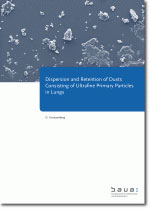| Nov 22, 2011 | |
Dispersion and retention of dusts consisting of nanoparticles in lungs |
|
| (Nanowerk News) This project aimed at studying the dispersion and retention behavior of dusts consisting of nanoscaled primary particles. Toxicological studies have demonstrated that the effects observed for nanoscaled particles are better correlated to the particle surface or particle number than to the administered mass doses. The toxicokinetic fate of nanoscaled particles and the potential effects induced after deposition in lungs are predominantly determined by the agglomeration status. Sytemic particle effects, i.e. effects on the remote organs, in addition to those on the target organ respiratory tract are conceivable only for particles with a nanoscaled aspect. | |
 In this study various types of nanoscaled particles, i.e titanium dioxide, carbon black, constantan and zinc oxide (if possible in pairs of different surface characteristics) were dispersed in physiologically compatible media or generated as aerosols with well-defined characteristics. For aequeous nanoparticle suspensions, the hydrodynamic mean diameter and the ζ potential were determined, for aerosols the particle number or mass concentrations and the mass median aerodynamic diameter (MMAD). For aqueous formulation of nanoparticles, phosphate buffer, sometimes including auxiliaries such as bovine serum albumin (BSA) or Tween® 80 (non-ionic surfactant), was used. Artificial lung fluids described in the literature or commercially available types were also included in some studies. The dispersion of nanoscaled bulk materials in liquid formulation requires a particle-specific approach and is usually an empirical process depending on surface character, ζ potential and clumping status of the bulk materials. However, an appropriate treatment combining high shear forces (mechanical homogeniser), ultrasonic treatment, vortexing and simple shaking can regularly provide suspensions with substantial moieties of nanoscaled particle fractions, normally stable for hours, some days or even longer periods. In contrary, it is difficult to generate stable dispersions with a defined agglomerate diameter in between the nano- and microscaled range (e.g. for a diameter range of approx. 700 nm). In an in vitro approach selected human bronchial and alveolar epithelial cell lines as well as fibroblasts grown on membranes were exposed from the apical side to the different particle types. After 1 hour the particles were detected by TEM technique in particular on the cellular surface whereas after 24 hours they were predominantly located in the cytoplasm. The most useful cell types in these experiments were A549 cells. For the hydrophilic TiO2 P25 the agglomerates tend to increase comparing the 1-hour to the 25-hour timepoint. The hydrophobic counterpart TiO2 T805 and carbon black Printex® 90 did not show a change in size with time. In an in vivo approach rats were exposed to aqueous dispersions (administered by intratracheal instillation) or nanoparticle aerosols (inhalation) and alterations in the particle size distribution were studied using transmission electron microscopy (TEM) as well as the bronchoalveolar lavage (BAL) technique. Exemplarily, in BAL fluid after instillation, TiO2 P25 increased in agglomerate size whereas TiO2 T805 did not show a change as compared to the stock suspension. Two acute inhalations with exposure of rats to nanoaerosols of constantan (electric spark generator) with controlled mean diameters of 43 nm (without aging) and 124 nm (aging) were conducted. The TEM analysis of lungs revealed that nanoscaled particles were merely detectable in the alveolar lumen. Despite intense examination of lungs prepared at different time-points only in one case an approx. 100 nm constantan particle was detected, i.e. 1 h after end of inhalation in the cytoplasm of an epithelial cell (exposure to 43 nm particles). Another experimental inhalation set-up used constantan formulated in a stable dispersion that was nebulised. This technique generating microscaled two-component (particle/buffer) intermediate particles of the mixed allowed the deposition of higher particles masses in lungs while keeping the nanosize aspect of particles. |
|
| Finally, a special approach used europium oxide (member of the oxide class of rare earths). As an additional endpoint, the chemical analysis of toxicokinetics was included to trace the fate of Eu2O3 particles following deposition in lungs. Although the Eu2O3 suspension included a nanoscaled particle fraction only small Eu2O3 amounts were detected in remote organs (with the highest values found in livers amounting to 0.1-0.9% of the value measured in lungs). | |
| Based on the results in various approaches, a tendency of nanoscaled particles to form larger size agglomerates following deposition and interaction with cells (in vitro) or the respiratory tract (in vivo) is predominant. The contrary trend, i.e. the increase of particle number due to a disintegration of agglomerates seems not to be of high relevance. | |
| Source Document | |
|
O. Creutzenberg: Dispersion and retention of dusts consisting of ultrafine primary particles in lungs. (pdf, 21.3 MB) 1. edition. Dortmund: Bundesanstalt für Arbeitsschutz und Arbeitsmedizin 2011. 141 pages, Project number: F 2133 |
| Source: Bundesanstalt für Arbeitsschutz und Arbeitsmedizin |
